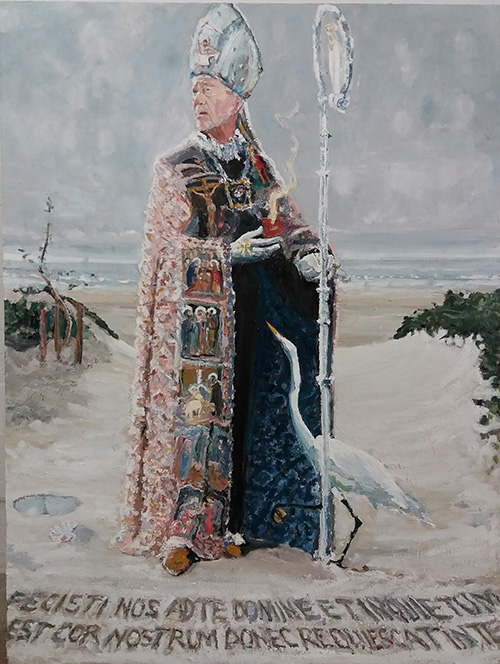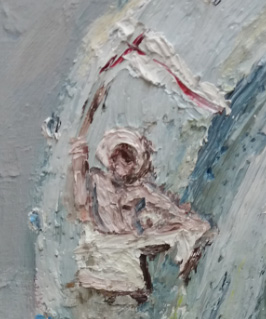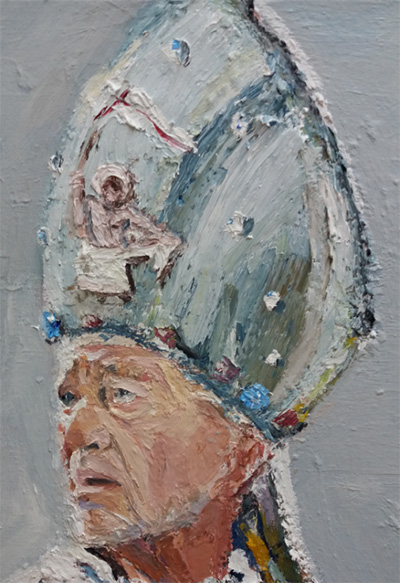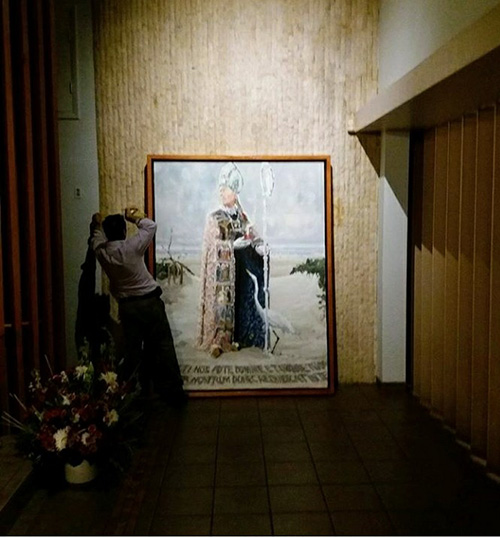By Anne DiBernardo - Florida Catholic
Editor’s note: Florida Catholic freelancer Anne DiBernardo is Chris Mangiaracina’s sister.

Photographer: ANNE DIBERNARDO | FC
Artist Christopher Mangiaracina's work, "St. Augustine of Hippo," was dedicated Oct. 13, 2017 and donated to St. Augustine Church and Catholic Student Center in memory of the artist's late father, Salvatore J. Mangiaracina.
CORAL GABLES | In commemoration of Trinity Sunday — celebrated each year on the Sunday after Pentecost — a painting by a local artist invites Catholics to reflect upon one of the most confounding of all sacred mysteries.
Chris Mangiaracina’s contemporary interpretation of St. Augustine of Hippo and the legendary “Parable of the Trinity” now dominates the alcove to the right of the altar at St. Augustine Church and Student Center in Coral Gables.
The life-size painting evolved from the South Florida artist’s desire to revive sacred art in the Church. He took his cue last year when his pastor, Msgr. Tomas Marin, told parishioners of his wish to acquire a new painting of St. Augustine for the parish. That same evening, Mangiaracina introduced himself and offered his services.
“Monsignor Marin was very gracious in trusting my own vision of the painting. He took every opportunity to yield to my artistic judgment, but I wanted to make sure he also contributed his thoughts on the iconography of St. Augustine,” Mangiaracina said. “It is an artist’s responsibility to embrace that iconography in some way, as an effective and faithful representation of that saint’s contribution, aiding us in our own spiritual journey.”
The painting was completed Oct. 13, 2017, the feast of Our Lady of Fatima, and hung Nov. 8, 2017.

Detail of artist Christopher Mangiaracina's work, "St. Augustine of Hippo." The image of Jesus shaking off his burial garment while holding the victorious flag of his resurrection is depicted on the mitre.
“Every time I see it, it tells me something else about St. Augustine,” Msgr. Marin said. “People are constantly asking about the painting, which is a great motivator on the theology of St. Augustine and the person of St. Augustine.”
Mangiaracina’s belief that sacred art should stir the viewer to more fully contemplate the mystery of the heavenly banquet is not new. Msgr. Terence Hogan, dean of the School of Theology and Ministry at St. Thomas University, and North American chaplain of the Patrons of the Arts in the Vatican Museums, points to the Church document “Built of Living Stones: Art, Architecture, and Worship,” which contains specific guidelines for religious art set forth by the U.S. Conference of Catholic Bishops.
Church art should evoke the culture, the past, and the future while also lifting the viewer to a heavenly dimension, Msgr. Hogan said. “You have to take your time and really look at the art, how it speaks to that particular time and particular place.”
EVOLUTION OF SYMBOLISM
It seemed natural, given Miami’s proximity to the beach, for St. Augustine to be represented within the setting of the Parable of the Trinity, explained Mangiaracina.

Detail of artist Christopher Mangiaracina's work, "St. Augustine of Hippo": St. Augustine's face looking up to the Lord. The artist asked his now deceased father, Salvatore Joseph Mangiaracina, to pose for the face of St. Augustine. The painting is dedicated to him in loving memory.
According to the story, a child is running back and forth with a seashell, scooping water from the sea to a little hole in the sand. St. Augustine asks the child, “Why are you doing this?” He replies, “I am moving all the water from the sea into this hole.” St. Augustine quips, “This is impossible!” to which the child replies, “It is no more impossible than for you to understand in its fullness the mystery of the Holy Trinity” — which is precisely what St. Augustine had been contemplating while walking along the shore.
A seashell and a puddle of water depicted in Mangiaracina’s painting are taken from St. Augustine’s iconography and honor this legend. Although Mangiaracina introduces new motifs in the painting that are a signature of his work — an egret and a sapling supported by a tripod of wood — they are culturally relevant and metaphorically congruent with the spiritual philosophy of this Doctor of the Church.
The scallop shell and water hole remain to his right, but the child has been replaced by a young sapling supported by three stakes. Mangiaracina explained that, prior to St. Augustine’s conversion, he was tempted to learn everything. But then he realized that faith precedes understanding and it was more important to appreciate the mystery. The sapling’s presence says, “Be patient, you’ll grow.”
St. Augustine is also known for the phrase, “You have formed us for yourself O Lord, and our hearts are restless until they rest in You.”
“Having just raked these words [in Latin] with his crozier through the sand, Augustine found that the burning within us, which leads to many disordered affections, is ultimately fulfilled in Jesus Christ alone,” Mangiaracina explained. “Since his theology embraced the idea that everything is made by God and for God and that everything will be drawn to him, his idea of restlessness would even include this local egret, which joins Augustine, whose heart is afire, gazing at our Lord.”
The artist portrayed St. Augustine using traditional iconography.
“I learned that although St. Augustine would never have worn an elaborately decorated cope, richly adorned mitre and crozier, white gloves, and sandals, he is often portrayed wearing these vestments to represent his particular state in heaven,” Mangiaracina said.
CENTRALITY OF MARY
Mary is also represented in the painting.
“St. Augustine understood that Mary participates in the Trinity in a singular and unrepeatable way as Mother of God, Spouse of the Holy Spirit and Daughter of God the Father. It is she who leads us most assuredly and directly to total union with Jesus,” said Mangiaracina. “So although St. Augustine is looking at our Lord crucified on the center of the parish altar, his restless, flamed heart is pulled toward the image on his crozier, Our Lady of Fatima. Monsignor Marin suggested that the edging of his cope be embellished with scenes depicting her centrality in the life of Jesus.”

Photographer: ANNE DIBERNARDO | FC
Jesus Mesa of Custom Quality Framing installs the paining "St. Augustine of Hippo," by Christopher Mangiaracina. Mesa donated his work building and installing the painting at St. Augustine Church and Student Center on Nov. 8, 2017.
The image on the coupling for the cope is Jesus crowned with thorns. On the mitre he is shaking off his burial garment and holding the victorious flag of his resurrection.
Msgr. Marin also suggested that St. Helen of the Cross be represented. Her prayers, like those of St. Monica’s, led to the conversion of her son, the Emperor Constantine. She is depicted above St. Augustine’s left breast, embracing the True Cross she recovered in Jerusalem.
“My recently deceased father, Salvatore, posed for St. Augustine’s face and I had asked him to look up as though he was looking up to our Lord. Monsignor was very pleased with the expression,” Mangiaracina said.
ART OF SACRED ART
Susan Moore, an interior designer and art collector who attends Our Lady of the Lakes Church in Miami Lakes, made a special trip to St. Augustine Church to view the painting. Her reaction: “Chris’ style and interpretation of St. Augustine bridges the old masters and the new art elegantly and respectfully. His art is so moving and inspiring and it gives my heart a divine charge.”
“Sacred art ought to be done in a state of prayer,” Mangiaracina said, adding, “an artist should always surrender himself when making a painting.” In this case, the surrender is not only to a sense of tradition but to whom he surrendered his life — the Trinity.
“Many secular artists will refer to it in other ways, such as energy, but as Catholics we embrace more directly and clearly the true origins of who is responsible for this creation,” Mangiaracina said, “because we are not really creating anything. We are being moved by our Creator to speak to his creation.”
ABOUT THE ARTIST
Chris Mangiaracina’s career spans 38 years. In addition to having had a mid-career retrospective at the University of Miami’s Lowe Art Museum, his work is collected privately and publicly worldwide and cited in various art and culture publications. More of his work can be viewed at beauxartsdesameriques.com and chrismangiaracina.com.

